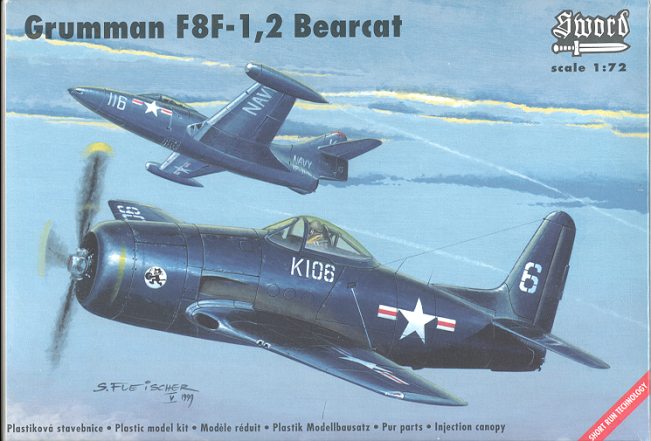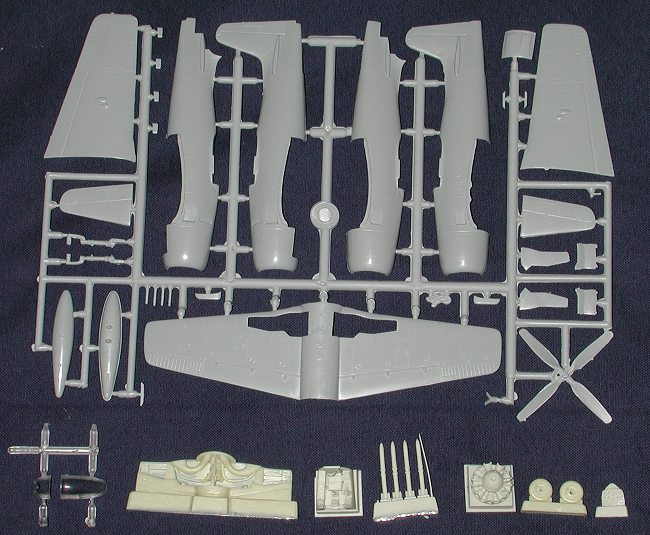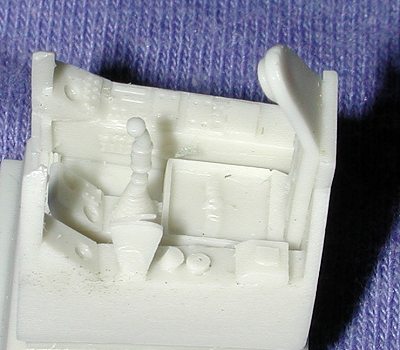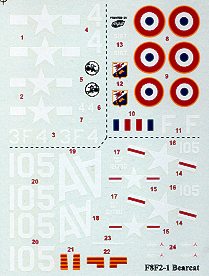
| KIT: | Sword 1/72 F8F-1/2 Bearcat |
| KIT # | 72006 |
| PRICE: | $14.98 |
| DECALS: | several aircraft |
| REVIEW & | |
| NOTES: |

| HISTORY |
Grumman's stubby little Bearcat was the last of the line forGrumman piston-engined aircraft that started with the FF-1 of 1931. Whenplanning a replacement for the F6F Hellcat, Grumman engineers decided to buildthe smallest interceptor as possible around the reliable and powerful Pratt& Whitney R-2800 engine.
First flying in August 1944, the aircraft quickly went througharmament and carrier qualifications. By May of 1945 the aircraft was cleared forfleet use. Pilots loved the superbly quick and agile Bearcat. It shared onetrait in common with today's computer controlled aircraft, though perhaps itwent about it in a different way. In the F-16, for example, the computer willnot let the pilot overstress the airframe and will override pilot inputs if heattempts to do so. The Bearcat also had an 'automatic' system to prevent thepilot for overstressing the airframe. The outer 40 inches of the wings weredesigned to separate from the airframe rather than cause catastrophic wingfailure due to over stressing. This would get the pilot's attention and requirehim to stop overstressing the aircraft. After this occurred a few times, it wasdecided that it really wasn't such a great idea and so the feature was removedfrom additional airframes.
The F8F was just days away from combat in WWII, when VF-18 andVF-19 were on their way to Japan aboard the USS Langley when the war ended. Bythe time the Korean war came about, the Bearcat had been replaced by jetfighters, though they still had their chance at combat with the French inVietnam in the early 50's. Several Bearcats are still flying today by proudwarbird owners.
| THE KIT |

Sword is a company that few have had any real experience with.As with so many other short run models, it comes from the Czech Republic, so hasmany of the same traits that one expects from those kits. In this case it isfinely detailed parts, a bit of flash, thick sprue attachments and resin detailparts. This kit also includes an injected plastic canopy which can be displayedin the open position if desired.
 Other options areunderwing rocket stubs and the ability to build either an F8F-1 or F8F-2version. Sword has taken a rather interesting way of offering both long andshort tailed Bearcats. They have offered two different fuselages. This is agreat idea as it eliminates all the problems that come from plugging in thevarious different bits to make the specific version you want to build. If notdoing a cannon armed version, you do have to sand off the upper wing bulges, butthat is a minor chore. One thing I don't like is that there is no separateengine cowling. Perhaps that is beyond the technology of short run kits.
Other options areunderwing rocket stubs and the ability to build either an F8F-1 or F8F-2version. Sword has taken a rather interesting way of offering both long andshort tailed Bearcats. They have offered two different fuselages. This is agreat idea as it eliminates all the problems that come from plugging in thevarious different bits to make the specific version you want to build. If notdoing a cannon armed version, you do have to sand off the upper wing bulges, butthat is a minor chore. One thing I don't like is that there is no separateengine cowling. Perhaps that is beyond the technology of short run kits.
The resin with the kit is quite good and is surely better thanany injected parts. The resin bits are the wheel wells (complete with the myriadof tubing that is found there), interior (and this is a full interior, seeimage), rockets, engine, wheels and instrument panel. Instructions are a bitbasic but adequate to do the job, giving six construction steps with colorcallouts in each step. Colors given are generic and not referenced to FS 595standards or a specific paint line. There is an addendum sheet to indicate whatneeds to be done to build which version.
Decals are for three aircraft, but there is no indication ofwhich decals  are for which versionother than looking at the drawings. No units are given on the instruction sheeteither. It is the addendum sheet that gives some clues as to which versions forwhich units. Decals are well done and glossy. The three aircraft are all paintedoverall dark sea blue. The -1 is for VF-3 sometime after the war and before1947. The -1B is for GC 1/22, a French unit in Vietnam circa 1953, finally a -2from VF-151 around 1948. The box art aircraft is not included on the decalsheet. The decal sheet to left is deliberately too dark so you can see the whitedecals.
are for which versionother than looking at the drawings. No units are given on the instruction sheeteither. It is the addendum sheet that gives some clues as to which versions forwhich units. Decals are well done and glossy. The three aircraft are all paintedoverall dark sea blue. The -1 is for VF-3 sometime after the war and before1947. The -1B is for GC 1/22, a French unit in Vietnam circa 1953, finally a -2from VF-151 around 1948. The box art aircraft is not included on the decalsheet. The decal sheet to left is deliberately too dark so you can see the whitedecals.
Overall, it looks like a pretty good kit. There is a bit morecleanup than with some of the newer short run kits, but nothing that anintermediate level modeler couldn't handle. One thing for sure, it is about timewe had a newer mold than the older, but still pretty nice Monogram Bearcat.
| REFERENCES |
Grumman Aircraft since 1929 by Rene J Francillon, 1989
Review kit courtesy of me and my wallet!
If you would like your product reviewed fairly and quickly by asite that has over 1,700 visits a day, please contactme or see other details in the